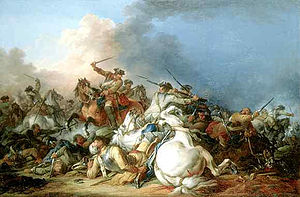art.wikisort.org - Artist
Francesco Giuseppe Casanova (1 June 1727, London – 8 July 1803, near Mödling) was an Italian painter who specialised in battle scenes. His older brother was Giacomo Casanova, the famous adventurer, and his younger brother was Giovanni Casanova; also a well-known painter.

Biography

He was born in London, where his parents, Zanetta Farussi, an actress, and Gaetano Casanova, an actor and dancer, had a theatrical engagement.[1] It was rumoured that his father was actually the Prince of Wales (who shortly after became King George II); whether for scurrilous motives or publicity is unclear.[citation needed] They returned to Venice when he was still young and, after his father's death in 1733, he and his siblings were placed in the care of the Grimani family.[1]
His career began in the workshops of Giovanni Antonio Guardi,[2] a very unpleasant time for him, according to the memoirs of his brother Giacomo. Later, he moved to the studios of Antonio Joli, who was a set designer for the theatres owned by the Grimanis. This was also, apparently, unsatisfactory and he took up studies with the battle painter, Francesco Simonini.[2] In 1751, upon his brother Giovanni's advice, he went to Paris and became an apprentice of Charles Parrocel.[1] The following year, after Parrocel's death, he went to Dresden and spent a year studying the battle paintings at the "Gallery of the Electors of Saxony". In 1758, he returned to Paris and set himself up as a free-lance artist.
Success did not come immediately, and his first exhibition was a failure. In 1761, he became a supernumerary member of the Académie royale de peinture et de sculpture and was promoted to full member in 1763.[2] As a result of favourable criticism from Denis Diderot, he began to receive commissions from the aristocracy.[3] Diderot would later express negative opinions about Casanova's work, but his reputation was already made.[4] His fame soon spread eastward and he received commissions from Catherine the Great for the Hermitage, beginning in 1768. Two years later, he produced his four famous "disaster paintings", which were purchased by Jean-Benjamin de la Borde on behalf of King Louis XV. In 1771, he exhibited two large canvases depicting scenes from the Thirty Years' War (The Battle of Freiburg and the Battle of Lens) and once again won Diderot's approval.
Personal life

In 1762, he had married Jeanne-Marie Jolivet (1734–1773) a ballerina with the theatre of the Comédie-Italienne who was known as "Mademoiselle d'Alancour". Her professional connections also supplied him with many clients. In 1775, two years after her death, he married the recently widowed Jeanne Cathérine Delachaux (1748–1818). The marriage turned out to be a disaster, so he abandoned her in 1783,[5] aided and abetted by Giacomo. He took refuge in Vienna, under the protection of Prince Charles Joseph de Ligne, who introduced him to Chancellor Kaunitz. It appears that Francesco was almost as extroverted and entertaining as his brother Giacomo, so he quickly became popular at the Viennese Court.
In addition to his paintings, he produced designs for tapestries and upholstery which proved very lucrative. From 1770 to 1787, the Royal Beauvais Manufactory used more than seventy of his patterns. He also produced a number of etchings including Tambour russe à cheval, Les trois Cuirassiers, Le Drapeau, Choc de cavalerie, L’Ane et le Drapeau and Le Dîner du peintre Casanova.[6]
Despite his success and his many aristocratic clients, he squandered his money, was perpetually in debt, and died in poverty at his home near Mödling. The year is generally given as 1803, although some sources have 1805 or 1807.

References
- "Francis Casanova" by Lionel Henry Cust, from the Dictionary of National Biography, 1885–1900, Volume 09 @ Wikisource.
- Brief biography from the Enciclopedia Italiana @ Treccani.
- Diderot on Francesco Casanova, Salon 1761, in Diderot, Beaux-Arts, Essais sur la peinture, Garnier frères 1879 pp. 149–150 @ Google Books.
- Diderot on Francesco Casanova, Salon 1763 in Diderot, Beaux-Arts, Essais sur la peinture, Garnier frères 1879 p. 219 @ Google Books.
- Jeanne Delachaux @ Histoire de l'Europe.
- Prosper de Baudicour. Le peintre-graveur français continué. Tome premier. Paris 1859. pp. 133–137.
{{cite book}}: CS1 maint: location (link)
Further reading
- Roland Kanz, Die Brüder Casanova. Künstler u. Abenteurer, Deutscher Kunstverlag, 2013 ISBN 978-3-422-07211-4
- Ernest Dumonthier, Les Tapisseries d'Ameublement de la Manufacture Royale de Beauvais d'après François Casanova, Albert Morancé, 1921.
External links
- More works by Casanova @ the Base Joconde
- Another critique by Diderot from the Salon of 1765 @ Google Books.
На других языках
[de] Francesco Casanova
Francesco Giuseppe Casanova (* 1. Juni 1727 (bzw. unter diesem Datum getauft[1]) in London; † 8. Juli 1803 in Vorderbrühl) war ein italienischer Schlachtenmaler des 18. Jahrhunderts. Er war ein Bruder des Schriftstellers und Abenteurers Giacomo Casanova und des Malers Giovanni Casanova.- [en] Francesco Giuseppe Casanova
[fr] Francesco Casanova
Francesco Giuseppe Casanova, né le 1er juin 1727 à Londres et mort le 8 juillet 1803 à Vorderbrühl, est un peintre italien.[it] Francesco Casanova
Francesco Casanova (Londra, 1º giugno 1727 – Mödling, 8 luglio 1803) è stato un pittore italiano.[ru] Казанова, Франческо
Франче́ско Казано́ва (фр. Francesco Giuseppe Casanova; 1727, Лондон — 1802, под Мёдлингом) — живописец-баталист и пейзажист, брат знаменитого авантюриста Джакомо Казановы и художника Джованни Баттиста Казанова.Другой контент может иметь иную лицензию. Перед использованием материалов сайта WikiSort.org внимательно изучите правила лицензирования конкретных элементов наполнения сайта.
WikiSort.org - проект по пересортировке и дополнению контента Википедии